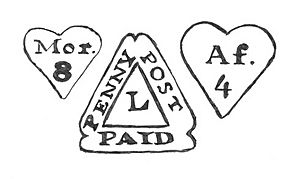Penny Post facts for kids
The Penny Post was a special postal system where you could send regular letters for just one penny. Imagine sending a letter across town for the same price as a small candy! Several Penny Post systems were set up in the United Kingdom and the United States. They made sending mail much cheaper and easier for everyone.
Contents
Penny Post in the United Kingdom
London's First Penny Post
In England, the postal service was run by the General Post Office since 1660. It had a monopoly, meaning it was the only service allowed to collect and carry letters between towns. However, there was no system for delivering letters to people's homes.
Then, in 1680, a man named William Dockwra and his partner Robert Murray started the London Penny Post. This was a local service. For just one old penny, you could send letters and packages weighing up to one pound within the cities of Westminster, London, and Southwark. Letters were delivered several times a day within the city. You could even send items to places up to ten miles outside London for an extra penny.
In 1683, Dockwra had to give up his Penny Post service to the English King. This happened because he was sending out newsletters that criticized the government.
Local Penny Post Services
In 1765, the government allowed towns and cities in Great Britain and Ireland to create their own Penny Posts. These services charged a single penny for mail within their local area, based on weight. By the early 1800s, many towns had these. You could often see markings like "PP" or "Penny Post" on the letters.
One interesting local Penny Post was in Edinburgh, Scotland. It was started in 1773 by Peter Williamson, also known as "Indian Peter." He combined the mail service with one of the world's first street directories. He had 17 shops in the city act as post offices. He also hired four uniformed postmen. Their hats said "Penny Post" and had numbers like 1, 4, 8, and 16 to make the business seem bigger.
The Uniform Fourpenny Post
On December 5, 1839, the Uniform Fourpenny Post was introduced by the General Post Office. This system charged four pence for letters. However, it only lasted for 36 days!
The Uniform Penny Post
The Uniform Penny Post was established on January 10, 1840. This change was largely due to the ideas of Rowland Hill. In 1835, he wrote a pamphlet called 'Post Office Reform'. His ideas helped make the postal system much better.
The Uniform Penny Post made sending letters safe, fast, and cheap across Great Britain and Ireland. From May 6, 1840, you could even pay for your letters using the world's first postage stamp, known as the Penny Black.
Ocean Penny Post
Elihu Burritt suggested a new idea called the Ocean Penny Post. He wanted a fixed rate of one penny for all mail sent anywhere in the entire British Empire. He believed this would help people around the world connect and create more unity.
Imperial Penny Post
On Christmas Day, 1898, the Imperial Penny Post began. This extended the one-penny rate across most of the British Empire. However, Australia and New Zealand didn't join until 1905. In 1908, the Penny Post rate was even extended to America.
The Penny Post rate in Great Britain finally ended in 1918.
Penny Post in the United States
In the United States, several local Penny Post services also existed.
Spaulding's Penny Post operated in Buffalo, New York from 1847 to 1850.
Davis' Penny Post ran in Baltimore, Maryland for a few weeks in February 1856. It left behind a few very rare stamps.
The Penny Post is also the name of a journal for a group called the Carriers and Locals Society. It was also the original name of a newspaper, The Cincinnati Post.


